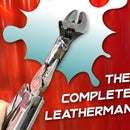Introduction: The Portable Laff Box
Let’s just point out the obvious, there is not a high demand for canned laughter these days, but making this project has given me the giggles. And as we all know it’s not much to laugh about these days (for future visitors, google COVID-19, Climate Change, Trump and the list goes on)
Which means it might be a good idea to pull out the odd laugh now!
I’d love to see this build inspire someone to do a different take on the Laff Box.
Crossing my fingers you’ll laugh!!!
Supplies
12V lead battery
Speakers X 3 (one large and two small)
Mono patch cables (eBay)
Stereo cables (2X 3.5mm - 2xRCA)
Stereo Amplifier board, mic input optional (dx0809 amplifier)
Potentiometers x 5
Kill-switch
Knobs for the mixer
Most importantly, use what you got and improvise:-)
Step 1: Inspiration
One of my favorite podcasts, 99% invisible had an episode featuring the Laff box (https://99percentinvisible.org/episode/the-laff-box), a mechanical laughter box for tv shows in the ’60s. It could play a bunch of different crowd laughter and other sounds an audience was expected to do, but sometimes didn’t … Laff box to the rescue!
Charles Douglass was the inventor of the original Laff Box:
https://en.wikipedia.org/wiki/Charles_Douglass
Step 2: My Favorite Can, the Jerrycan
I’ve had this can forever and knew something great could be stored inside:-)
This project was perfect! I like the rugged aesthetic and that it is so recognizable.
I made a first simple cut, a square in the bottom.
Step 3: The Drawer…
I wanted to exploit the full storage capacity so I needed to make a drawer I could pull out and utilize everything inside.
A little hard to see from these images but I found a way to attach the drawer slides. A metal L bar holds the slides.
Step 4: Speakers!
To have the audio blast from the pull-up lid I needed to make holes that were the size of my found/leftover speakers.
I also needed to protect the speakers. The solution was to cut some perforated sheet metal. I made some clearance with washers.
As you can see I also painted the can during this process, but left the paint job out, you don't have time to see paint dry:-)
Step 5: Wiring Up the Input/output
This took me some time:-)
But I have done the same type of mixer before when I made the Cine Ambulante… still, I had to do the soldering twice to have the volume knobs turn the right way:-)
Step 6: 1-2, 1-2… Testing
I really enjoy making builds that involve audio, but very often I dosen’t go as planned. So I made this little web page I’ve turned into a web app.
It allows me to play each audio channel, left, right, and both. (http://www.soupindustries.com/lab/app/leftright/soundcheck.html)
So before soldering, I bring out the crocodile cables and test the wiring.
Step 7: The Kill-switch
I just love the kill-switch! I try to implement it in all my builds. It has such a nice feel to it and it’s very recognizable:-)
I also added a voltmeter so I could easily see when recharging was needed.
I made a 3D print of the logo, two-color filament.
Step 8: Stereo to 2x Mono
For this, to work I decided early on to use two audio sources but in order to get as much variety, I needed to use both left and right stereo channels.
I made a simple design in Fusion360 and 3D printed this piece for splitting the audio cables. With stereo in, and out come two mono cables. The casing is made so you can print two of the same, they are mirrored. Use a 3mm screw. After soldering I used electrical tape for isolation.
The mono cables are colored so it will be easy to tell them apart. These cables are used for patching synth modules.
Step 9: Make Me Laugh
Now I had to go hunting for a good laugh! I sourced laughter from all over the place. YouTube, audio resources and TikTok! Once I had my four categories, child, male, female and crowd laughter I started to edit it all together.
The trick was to have two laughs on one track, using the right and left channels I could fit the four categories onto two cassettes.
I used Adobe’s audio software.
Once I had the tracks I made them 45 minutes long to fit on one side of the cassette. A lot of copying and pasting:-)
Finally I hooked my computer up with an old stereo deck that had recording for cassettes.
Maybe the two strangest A-side cassettes in my collection:-)
Step 10: Walkman to the Rescue
They are held in place by an aluminum piece that can be tightened.
Step 11: Battery and Wiring
On the side of the box I’ve made connections for recharging the battery. Had to make some custom fitting, 3D printed some washers for isolating.
Step 12: Open Mic for Laughter
When in operation you push to laugh! It’s connected to the amplifier board directly.
Step 13: Final Laugh Off!
I’m really happy with how this build turned out!
You can of course question the usefulness of having a Portable Laff Box, but again, I’ve learned so much from doing this project and would do it again.
This build is part of a larger project, Weapons of Mass Enjoyment, the Laff Box is the fourth element of this art installation.
Remember, laughter prolongs life, even canned laughter :-D
- - - - - - - - - - - - - - - - - - - - - - - - -
Please consider following my work in progress at Instagram: https://www.instagram.com/smogdog





